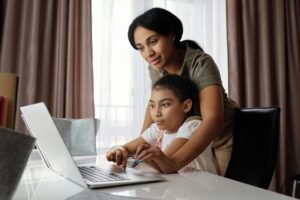All students are familiar with homework, but not all students view it as an enjoyable aspect of their study or especially engaging aspect. The end of class also correlates with a crazy rush to answer homework questions before the bell rings as struggling students fall between the gaps and pass their unfinished homework over. But now a new teaching paradigm called flipped learning is starting to take shape in schools across the world and is transforming classroom activities. The flipped classroom model is an educational approach that specifically transfers instruction from the school learning space to the individual learning space and the resultant school space is turned into a diverse, immersive learning atmosphere where the instructor leads the students in incorporating ideas and actively involving them in the subject matter. The flipped classroom is just one of the new home-schooling designs that have found its way into worldwide classrooms. The pedagogical paradigm attempts to reverse the function of homework instruction, from which students usually absorb new instructional material outside their classroom. Teachers then use their classroom sessions to allow the students to apply the learned knowledge, by giving a different set of assignments. The flipping classroom, also known as flipping schooling, was launched back in 2007 by Jon Bergmann and Aaron Sams, and the teachers and institutions alike have seen an appealing trend of acceptance. The flipped classroom model was pioneered to reflect a new progressive system of education, focusing on how to get the most out of students by adhering to their social patterns. An Online high school that wants to dig further into this model will integrate the so-called four foundations of flipped learning into its learning system; a flexible environment, a culture of learning, intentional content, and a professional facilitator.

A culture of learning refers to the fact that the participation in the curriculum means that, under the supervision and direction of the teacher, the student must consciously take responsibility for his or her learning to attain meaningful learning. The flexible environment is described by indicators relating to the Specific learning patterns identified by the curriculum and the fact that, based on the tasks to be carried out, the classroom may be modified in various ways. The instructor as a reference is flexible in terms of measuring the needs of both student’s successes and the learning times. The intentionally directed material refers to a mechanism. The teacher’s perspective in the preparation of appropriate material and the planning and scheduling tasks. The instructor must use constructive learning approaches and techniques that concentrate on the students and allow the achievement of the goals previously established, addressing the needs and desires of the environment in which the teaching takes place. The final pillar, qualified educators, underlines the value of maintaining a positive, self-critical approach towards their teaching practice for the teaching staff, aiming at a continual preparation cycle including cooperation and coordination with other teachers to share perspectives and constructive feedback. Concerning the pupils, the instructor must carry out formative evaluations that allow the identification of learning difficulties
The Flipped Classroom model is exactly as it seems. It reverses the complexities of mainstream schooling. Students do not learn new content in the classroom through this method. Instead, they learn it in their own time and place from video and online sources. Meanwhile, in the classroom, issues, and tasks that may once have been viewed as homework are now being discussed, as teachers provide customized advice. The classroom model supports the online education system. Many online high schools follow the four main pillars to start online learning.

1- As each student begins with past knowledge, it will take him more time to understand the same idea. Contrary to what happens in traditional education, where all students in the classroom must adopt the same pace, students in online education, according to the flipped classroom model use the time they require for each lesson. In this way, each pupil relies on their success to spending more or less time in each lesson to ensure that they correctly understand it.
2- In online education, the teacher-centric teaching component takes place out of the classroom meaning that class time can be devoted to student-centric activities according to the flipped classroom model. Teachers can perform other tasks, based on the students’ development. They can see if their students are struggling, and what subjects they will be improving.
3- The flipped classroom model supports online education to improve learning outcomes. When the students see their work is beneficial and learn well, their enthusiasm is stronger. Online teaching platforms allow you to create discussion groups with or without an instructor and, through chats or forums built into the learning process, speak to other students. Student enthusiasm improves when indulging in social learning.
These four pillars of the flipped classroom model all are per the online education. ISBerne Online school system is also an online education platform that fulfills the needs of the students. Students at ISBerne Online will earn their higher education certificate from everywhere in the world!





